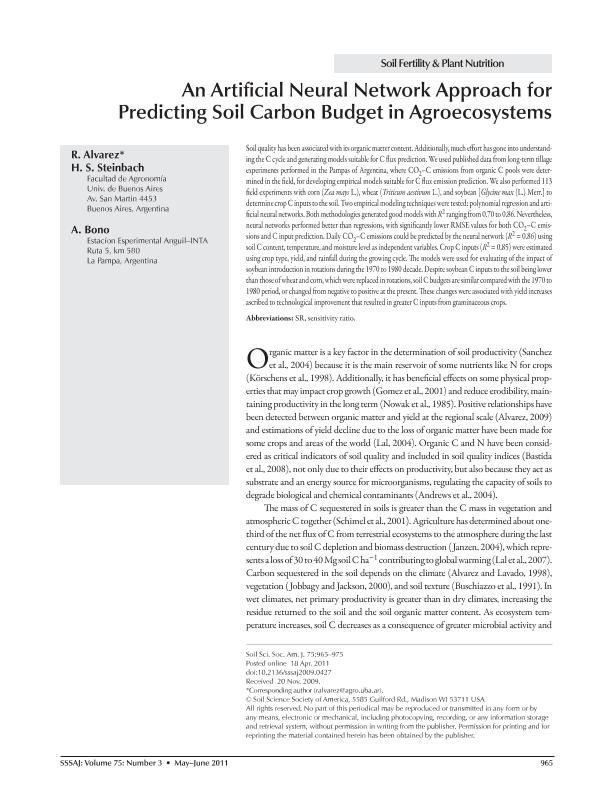Mostrar el registro sencillo del ítem
dc.contributor.author
Alvarez, Roberto

dc.contributor.author
Steinbach, Haydee Sara
dc.contributor.author
Bono, Alfredo
dc.date.available
2017-04-25T15:26:02Z
dc.date.issued
2011-06
dc.identifier.citation
Alvarez, Roberto; Steinbach, Haydee Sara; Bono, Alfredo; An artificial neural network approach for predicting soil carbon budget in agroecosystems; Soil Sci Soc Amer; Soil Science Society Of America Journal; 75; 3; 6-2011; 965-975
dc.identifier.issn
0361-5995
dc.identifier.uri
http://hdl.handle.net/11336/15702
dc.description.abstract
Soil quality has been associated with its organic matter content. Additionally, much effort has gone into understanding the C cycle and generating models suitable for C flux prediction. We used published data from long-term tillage experiments performed in the Pampas of Argentina, where CO2–C emissions from organic C pools were determined in the field, for developing empirical models suitable for C flux emission prediction. We also performed 113 field experiments with corn (Zea mays L.), wheat (Triticum aestivum L.), and soybean [Glycine max (L.) Merr.] to determine crop C inputs to the soil. Two empirical modeling techniques were tested: polynomial regression and artificial neural networks. Both methodologies generated good models with R2 ranging from 0.70 to 0.86. Nevertheless, neural networks performed better than regressions, with significantly lower RMSE values for both CO2–C emissions and C input prediction. Daily CO2–C emissions could be predicted by the neural network (R2 = 0.86) using soil C content, temperature, and moisture level as independent variables. Crop C inputs (R2 = 0.85) were estimated using crop type, yield, and rainfall during the growing cycle. The models were used for evaluating of the impact of soybean introduction in rotations during the 1970 to 1980 decade. Despite soybean C inputs to the soil being lower than those of wheat and corn, which were replaced in rotations, soil C budgets are similar compared with the 1970 to 1980 period, or changed from negative to positive at the present. These changes were associated with yield increases ascribed to technological improvement that resulted in greater C inputs from graminaceous crops.
dc.format
application/pdf
dc.language.iso
eng
dc.publisher
Soil Sci Soc Amer

dc.rights
info:eu-repo/semantics/openAccess
dc.rights.uri
https://creativecommons.org/licenses/by-nc-sa/2.5/ar/
dc.subject
Carbon Budget
dc.subject
Agroecosystems
dc.subject
Neural Network
dc.subject.classification
Otras Ciencias de la Tierra y relacionadas con el Medio Ambiente

dc.subject.classification
Ciencias de la Tierra y relacionadas con el Medio Ambiente

dc.subject.classification
CIENCIAS NATURALES Y EXACTAS

dc.title
An artificial neural network approach for predicting soil carbon budget in agroecosystems
dc.type
info:eu-repo/semantics/article
dc.type
info:ar-repo/semantics/artículo
dc.type
info:eu-repo/semantics/publishedVersion
dc.date.updated
2017-04-24T20:43:14Z
dc.journal.volume
75
dc.journal.number
3
dc.journal.pagination
965-975
dc.journal.pais
Estados Unidos

dc.description.fil
Fil: Alvarez, Roberto. Universidad de Buenos Aires. Facultad de Agronomia; Argentina. Consejo Nacional de Investigaciones Científicas y Técnicas. Oficina de Coordinación Administrativa Parque Centenario; Argentina
dc.description.fil
Fil: Steinbach, Haydee Sara. Universidad de Buenos Aires. Facultad de Agronomia; Argentina
dc.description.fil
Fil: Bono, Alfredo. Instituto Nacional de Tecnología Agropecuaria. Centro Regional la Pampa-San Luis. Estación Experimental Agropecuaria Anguil; Argentina
dc.journal.title
Soil Science Society Of America Journal

dc.relation.alternativeid
info:eu-repo/semantics/altIdentifier/url/https://dl.sciencesocieties.org/publications/sssaj/abstracts/75/3/965?access=0&view=pdf
dc.relation.alternativeid
info:eu-repo/semantics/altIdentifier/doi/http://dx.doi.org/10.2136/sssaj2009.0427
Archivos asociados
